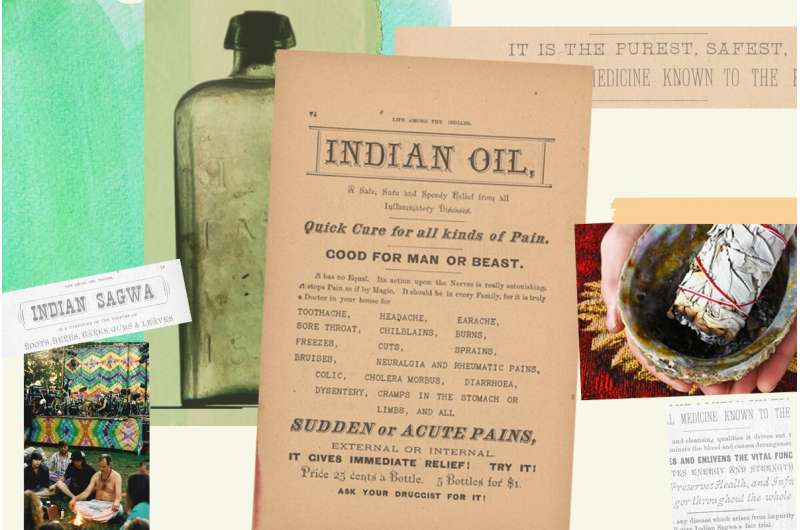This article has been reviewed according to Science X's editorial process and policies. Editors have highlighted the following attributes while ensuring the content's credibility:
fact-checked
trusted source
proofread
From 19th century 'Indian remedies' to New Age spirituality, research explores historical appropriation

Sarah Dees pulls several yellow-tinged booklets out of plastic bags. Flipping through one titled "Life Among the Indians," she points out sections on ceremonies and customs. Toward the back are ads for so-called "Indian remedies," products like "Kickapoo Indian Sagwa" and "Kickapoo Indian Worm Killer."
Dees, an assistant professor of American religions at Iowa State University, explains the booklets were part of a larger marketing campaign by the Kickapoo Indian Medicine Company. It was founded in 1881 by two Euro-American men, one of whom claimed a Kickapoo healer had saved his life with "Sagwa" and divulged its secret ingredients.
"While the Kickapoo Indian Medicine Company no longer exists, there are many examples today of companies that appropriate Indigenous cultures to turn a profit," says Dees. "By examining these historical instances of cultural appropriation, we can better understand more recent forms that have spread over the course of the 19th and 21st centuries and grapple with tough questions about appropriation vs. appreciation."
In a new peer-reviewed paper, Dees emphasizes it's common for people to draw from other cultures. But misrepresenting cultures or "hijacking narratives" for economic gain can cause harm, especially when unequal power dynamics are at play. Dees shows how the Kickapoo Indian Medicine Company pushed stereotypes and claimed authority on Indigenous cultures to sell products to non-Native consumers.
She also highlights several ironies. As "Indian remedies" became mainstream, the U.S. government rolled out policies to restrict Indigenous healing and spiritual practices, which Dees explains are often intertwined.
Kickapoo Indian Company
In the late 1800s, Dees says there was growing interest in "medicines purported to draw on Native American medicinal knowledge." Part of this was a backlash to the Industrial Revolution and Western medicine's harsh, sometimes deadly treatments, like bloodletting and mercury compounds.
The Kickapoo Indian Medicine Company advertised its remedies as harmless (because they were all natural) but also powerful in their ability to help people "achieve total well-being." The company frequently did this by exploiting the image of the "noble savage," a trope of an Indigenous person uncorrupted by civilization, morally pure and living in harmony with nature.
Dees says one of the reasons this stereotype is problematic is because it suggests Indigenous people must stay in the past to be authentic.
The Age of Aquarius
The number of Indian medicine companies declined with the Pure Food and Drug Act of 1906. But interest in Native American healing practices by non-Native people resurfaced again during the latter half of the 20th century. Dees explains an eclectic set of practices emerged with the New Age movement, which drew from earlier spiritualist ideas (e.g., seances, hypnotism,) eastern religions, old European pagan traditions and Indigenous ceremonies.
"One of the big critiques of New Age practices is that they're very individualistic. It's this idea that you can buy a blessing or pay $1,000 for a sweat lodge for your own personal betterment when Indigenous religious practices are communal and specific to a nation or a subgroup within that nation," says Dees.
This extraction of spiritual practices makes it harder for Indigenous communities to control narratives about the history and purpose of their traditions. Some also worry that sharing certain ceremonies and sacred sites with outsiders reduces their potency.
In her paper, Dees points to the 1993 Lakota Summit in which 500 members passed the "Declaration of War against Exploiters of Lakota Spirituality." It denounced the long process of "having [their] most precious Lakota ceremonies and spiritual practices desecrated, mocked and abused by non-Indian 'wannabes,' hucksters, cultists, commercial profiteers and self-styled 'New Age shamans' and their followers."
Cultural appreciation vs. appropriation
Whether it's Victoria's Secret models wearing headdresses or sage smudge sticks sold on Amazon, companies continue to profit from Indigenous cultures and healing practices. But Dees says there's also been more interest in finding the line between cultural appreciation and cultural appropriation.
"If someone's curious or unsure, I really encourage going to the source and finding multiple perspectives. You can learn a lot from Indigenous artists, writers and musicians because they're going to share stories from their lives and communities that they feel comfortable sharing," says Dees. "But also, I think it's good to remember that sometimes there are multiple perspectives. People's outlooks within one nation may differ greatly."
She also recommends that people who are interested in Native designs support Indigenous artists rather than buy 'Native-inspired' knockoffs.
More information: Dees, Sarah. Before and Beyond the New Age: Historical Appropriation of Native American Medicine and Spirituality / Antes Y Más Allá De La Nueva Era: Apropiación Histórica De La Medicina Y La Espiritualidad De Los Nativos Americanos. American Religion, vol. 4 no. 2, 2023, p. 17-44. Project MUSE muse.jhu.edu/article/896071
Provided by Iowa State University




















